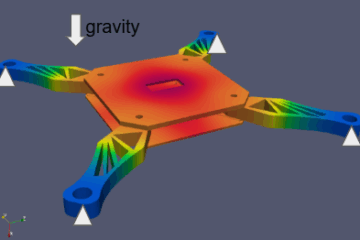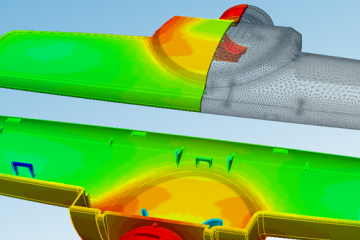Meeting UNI 11673-1-2017: Analyzing Thermal Performance of Windows with FEM and CalculiX
The building industry is increasingly focused on energy efficiency, and windows play a crucial role in a building’s overall thermal performance. The Italian standard UNI 11673-1-2017 provides specific requirements for evaluating the thermal transmittance (U-value) of windows and doors. One powerful method for achieving this analysis is using Finite Element Method (FEM) heat transfer simulations. In this post, we’ll explore how you can perform this analysis using the open-source software CalculiX.
Understanding UNI 11673-1-2017 and Thermal Transmittance
UNI 11673-1-2017 dictates the procedures for calculating the thermal transmittance (U-value) of windows and doors. The U-value quantifies how well a component resists heat transfer; a lower U-value indicates better insulation. This standard defines:
- Material Properties: Specifies the required thermal conductivity (λ) values for various materials used in window construction (glass, frame materials, etc.).
- Boundary Conditions: Defines the environmental conditions (ambient temperature, heat transfer coefficients) for simulating heat transfer realistically.
- Geometry: While not strictly defining geometry, it implicitly necessitates accurate representation of the window’s complex geometry for accurate thermal analysis.
Why Use FEM for Heat Transfer Analysis?
Traditional methods for estimating U-values can be limited by complex geometries or layered materials. FEM offers significant advantages:
- Complex Geometries: Handles intricate window frame profiles, glazing configurations, and other complex details with high accuracy.
- Heterogeneous Materials: Accommodates different materials with varying thermal properties precisely, capturing the nuanced behavior of heat flow.
- Detailed Temperature Maps: Provides visual representations of temperature distribution across the window, aiding in identifying areas of potential heat loss.
- Improved Accuracy: Offers a more precise calculation of the U-value compared to simpler analytical approaches.
CalculiX: Your Open-Source Powerhouse
CalculiX is a free and open-source FEA software package that is a great alternative to commercially available tools. Although it requires a command-line or text-based input approach, it is very capable.
Steps for Implementing a UNI 11673-1-2017 Analysis with CalculiX:
- Geometry Creation:
- Create a detailed 3D model of your window in a CAD software like FreeCAD, or other popular alternatives, that exports into STEP files.
- Import the geometry into a mesh preprocessor (e.g., Gmsh, Netgen).
- Meshing:
- Create a suitable mesh of tetrahedrals or hexahedral elements. A finer mesh in areas with high temperature gradients is important for accuracy.
- Material Property Definition:
- Create a text file to define the materials used (e.g., glass, PVC, aluminum) using CalculiX’s syntax.Specify material density, thermal conductivity (λ), specific heat capacity, and other parameters required for the analysis.
*MATERIAL, NAME=GLASS *DENSITY, 2500, *CONDUCTIVITY 1.0, - Boundary Condition Application:
- Set convection boundary conditions to the faces that are in contact with the environment according to the UNI 11673-1-2017 standard. This typically involves specifying the following parameters:
- Ambient temperatures (e.g., T_inside = 20 °C, T_outside = 0 °C) according to the standard or according to your scenario.
- Convection heat transfer coefficients (h_inside, h_outside) for both inner and outer surfaces. The standard typically suggests standard values.
- In CalculiX, you would typically apply these as heat flux boundary conditions.
- Set convection boundary conditions to the faces that are in contact with the environment according to the UNI 11673-1-2017 standard. This typically involves specifying the following parameters:
- Analysis Definition:
- Define a steady-state heat transfer analysis.
- Specify output requests to obtain temperature and heat flux results.
- CalculiX Input File (.inp):
- Assemble the meshed geometry, material properties, boundary conditions, and analysis parameters into a single
.inpinput file using CalculiX’s syntax. - You will need to use the command line and a text editor to create and modify the file.
*HEADING Window Thermal Analysis *INCLUDE, INPUT=window_mesh.inp *MATERIAL, NAME=GLASS *DENSITY 2500 *CONDUCTIVITY 1.0 *MATERIAL, NAME=PVC *DENSITY 1400 *CONDUCTIVITY 0.16 *MATERIAL, NAME=AIR *DENSITY 1.225 *CONDUCTIVITY 0.026 *ELEMENT, TYPE=DC3D10, ELSET=glass *ELEMENT, TYPE=DC3D10, ELSET=frame *ELEMENT, TYPE=DC3D10, ELSET=air_gap *SURFACE, NAME=inside_surface, TYPE=ELEMENT *SURFACE, NAME=outside_surface, TYPE=ELEMENT *SURFACE, NAME=frame_surface, TYPE=ELEMENT *STEP, NLGEOM=NO *STEADY STATE HEAT TRANSFER *DSLOAD inside_surface, BF, 20, 15 outside_surface, BF, 0, 25 *NODE FILE, OUTPUT=3D, FREQ=1 U *EL FILE, OUTPUT=3D, FREQ=1 HFL *END STEP - Assemble the meshed geometry, material properties, boundary conditions, and analysis parameters into a single
- CalculiX Execution:
- Run the CalculiX solver using the command line:
ccx your_input_file.inp
- Run the CalculiX solver using the command line:
- Post-Processing and Results Interpretation:
- Use CalculiX post-processing tools or dedicated software (like ParaView) to visualize the temperature field and heat flux distribution.
- Use the results to extract the total heat flow through your window and calculate the U-value (W/m2K) using the following equation:
U = q / (A * ΔT)
Where:
q = Total heat flux through the window (W)
A = Area of the window (m^2)
ΔT = Temperature difference between inside and outside
Key Considerations:
- Mesh Convergence: Conduct mesh convergence studies to ensure your results are not significantly affected by mesh size.
- Material Properties: Use accurate material properties as specified in UNI 11673-1-2017 or from reputable material databases.
- Boundary Conditions: Apply boundary conditions precisely according to the standard.
- Validation: Validate your simulations with experimental data whenever possible.
Conclusion
FEM analysis with CalculiX provides a robust and cost-effective method for evaluating the thermal performance of windows according to UNI 11673-1-2017. By correctly defining the geometry, material properties, and boundary conditions, engineers and designers can accurately assess U-values, optimize window designs, and contribute to more energy-efficient buildings. While the learning curve of CalculiX can be a little steeper than commercially available tools, its open-source nature and powerful capabilities make it an invaluable tool for thermal simulations in building design.
This post provides a conceptual outline. Remember to consult the specific UNI 11673-1-2017 document for complete requirements, and to consult the CalculiX documentation for specific details about setting up your input file. Good luck with your thermal simulations!
CloudHPC is a HPC provider to run engineering simulations on the cloud. CloudHPC provides from 1 to 224 vCPUs for each process in several configuration of HPC infrastructure - both multi-thread and multi-core. Current software ranges includes several CAE, CFD, FEA, FEM software among which OpenFOAM, FDS, Blender and several others.
New users benefit of a FREE trial of 300 vCPU/Hours to be used on the platform in order to test the platform, all each features and verify if it is suitable for their needs


